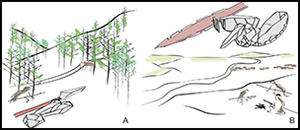Crossref Citations
This article has been cited by the following publications. This list is generated based on data provided by
Crossref.
2015.
Current Bibliography of the History of Science and Its Cultural Influences, 2015.
Isis,
Vol. 106,
Issue. S1,
p.
i.
Sato, Hiroyuki
and
Natsuki, Daigo
2017.
Human behavioral responses to environmental condition and the emergence of the world's oldest pottery in East and Northeast Asia: An overview.
Quaternary International,
Vol. 441,
Issue. ,
p.
12.
Iizuka, Fumie
and
Izuho, Masami
2017.
Late Upper Paleolithic-Initial Jomon transitions, southern Kyushu, Japan: Regional scale to macro processes a close look.
Quaternary International,
Vol. 441,
Issue. ,
p.
102.
Yang, Shi‐Xia
Zhang, Yu‐Xiu
Li, You‐Qian
Zhao, Chao
Li, Xiao‐Qiang
Yue, Jian‐Ping
Hou, Ya‐Mei
Deng, Cheng‐Long
Zhu, Ri‐Xiang
and
Petraglia, Michael D.
2017.
Environmental change and raw material selection strategies at Taoshan: a terminal Late Pleistocene to Holocene site in north‐eastern China.
Journal of Quaternary Science,
Vol. 32,
Issue. 5,
p.
553.
Morisaki, Kazuki
Izuho, Masami
and
Sato, Hiroyuki
2018.
Lithic Technological Organization and Paleoenvironmental Change.
Vol. 9,
Issue. ,
p.
91.
Izuho, Masami
Kunikita, Dai
Nakazawa, Yuichi
Oda, Noriyoshi
Hiromatsu, Koichi
and
Takahashi, Osamu
2018.
New AMS Dates from the Shukubai-Kaso Site (Loc. Sankakuyama), Hokkaido (Japan): Refining the Chronology of Small Flake-Based Assemblages during the Early Upper Paleolithic in the Paleo-Sakhalin-Hokkaido-Kuril Peninsula.
PaleoAmerica,
Vol. 4,
Issue. 2,
p.
134.
Yue, Jian-Ping
Li, You-Qian
and
Yang, Shi-Xia
2019.
Neolithisation in the southern Lesser Khingan Mountains: lithic technologies and ecological adaptation.
Antiquity,
Vol. 93,
Issue. 371,
p.
1144.
Morisaki, Kazuki
Sano, Katsuhiro
and
Izuho, Masami
2019.
Early Upper Paleolithic blade technology in the Japanese Archipelago.
Archaeological Research in Asia,
Vol. 17,
Issue. ,
p.
79.
Lee, Gi-Kil
and
Sano, Katsuhiro
2019.
Were tanged points mechanically delivered armatures? Functional and morphometric analyses of tanged points from an Upper Paleolithic site at Jingeuneul, Korea.
Archaeological and Anthropological Sciences,
Vol. 11,
Issue. 6,
p.
2453.
Morisaki, Kazuki
Oda, Noriyoshi
Kunikita, Dai
Sasaki, Yuka
Kuronuma, Yasuko
Iwase, Akira
Yamazaki, Takeshi
Ichida, Naoichiro
and
Sato, Hiroyuki
2019.
Sedentism, pottery and inland fishing in Late Glacial Japan: a reassessment of the Maedakochi site.
Antiquity,
Vol. 93,
Issue. 372,
p.
1442.
Yue, Jian-Ping
Yang, Shi-Xia
Hou, Ya-Mei
Potter, Ben A.
Li, You-Qian
and
Chang, Yang
2020.
Late Pleistocene lithic technology and human adaptation in Northeast China: A case study from Taoshan site.
Quaternary International,
Vol. 535,
Issue. ,
p.
48.
Hashemi, Seyyed Milad
Vahdati Nasab, Hamed
Berillon, Gilles
and
Oryat, Mona
2021.
An investigation of the flake-based lithic tool morphology using 3D geometric morphometrics: A case study from the Mirak Paleolithic Site, Iran.
Journal of Archaeological Science: Reports,
Vol. 37,
Issue. ,
p.
102948.
Zhang, Meng
2021.
Rethinking Microblade Technology Research in Northeastern Asia.
Journal of Paleolithic Archaeology,
Vol. 4,
Issue. 3,
Park, Gayoung
and
Marwick, Ben
2022.
How did the introduction of stemmed points affect mobility and site occupation during the late Pleistocene in Korea?.
Quaternary Science Reviews,
Vol. 277,
Issue. ,
p.
107312.
Fukuda, Masahiro
Morisaki, Kazuki
and
Sato, Hiroyuki
2022.
Maritime Prehistory of Northeast Asia.
Vol. 6,
Issue. ,
p.
73.
Picin, Andrea
Wedage, Oshan
Blinkhorn, James
Amano, Noel
Deraniyagala, Siran
Boivin, Nicole
Roberts, Patrick
Petraglia, Michael
and
Garvey, Raven
2022.
Homo sapiens lithic technology and microlithization in the South Asian rainforest at Kitulgala Beli-lena (c. 45 – 8,000 years ago).
PLOS ONE,
Vol. 17,
Issue. 10,
p.
e0273450.
Davis, Loren G.
Madsen, David B.
Sisson, David A.
Becerra-Valdivia, Lorena
Higham, Thomas
Stueber, Daniel
Bean, Daniel W.
Nyers, Alexander J.
Carroll, Amanda
Ryder, Christina
Sponheimer, Matt
Izuho, Masami
Iizuka, Fumie
Li, Guoqiang
Epps, Clinton W.
and
Halford, F. Kirk
2022.
Dating of a large tool assemblage at the Cooper’s Ferry site (Idaho, USA) to ~15,785 cal yr B.P. extends the age of stemmed points in the Americas.
Science Advances,
Vol. 8,
Issue. 51,
Morisaki, Kazuki
2022.
What motivated early pottery adoption in the Japanese Archipelago: A critical review.
Quaternary International,
Vol. 608-609,
Issue. ,
p.
65.
Morisaki, Kazuki
Shiba, Kojiro
and
Choi, Donghyuk
2022.
Examining frequency and directionality of Palaeolithic sea-crossing over the Korea/Tsushima Strait: a synthesis.
World Archaeology,
Vol. 54,
Issue. 2,
p.
162.





